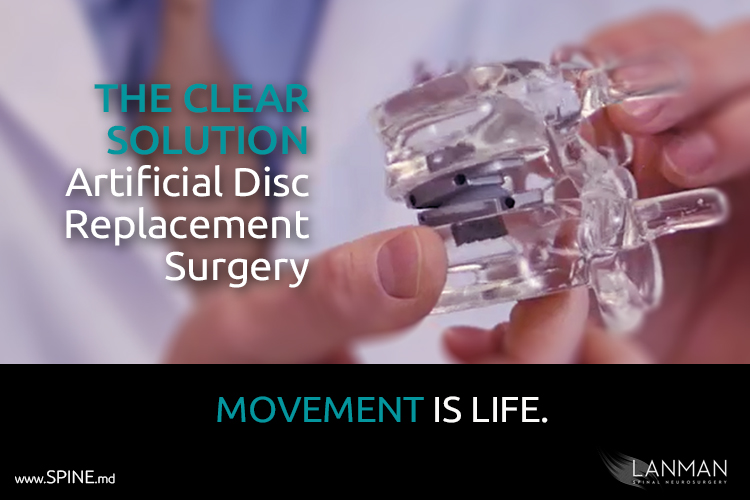ADR is no longer an alternative; it’s the clearly the solution.
I see a lot of patients from all walks of life. Some of them are actors and professional athletes; some are business executives and entrepreneurs; most are average people of all ages that have neck and back pain issues that are so severe that they need medical help. That’s when I get to work with solutions so that they can quickly go back to their active lives.
Most of my patients have done extensive research on their own so that they know what they’re looking for and what they need for a cure. By the time they reach me, they know who I am and that I’ve done extensive, long-term research and clinical trials on artificial disc replacement surgery.
One of the first things that my patients discover about me is that I’m a spinal neurosurgeon practicing for 25 years at my practice in Beverly Hills, CA. I’m a professor at UCLA School of Medicine, a faculty surgeon at the Cedar-Sinai Medical Center in Los Angeles, and a member of the Cedar-Sinai Institute for Spinal Disorders.
My patients also learn that I have been treating patients with motion preservation surgery for my entire professional career. The goal is not just to make neck and back pain patients “better” (as in, pain-free), but greater than better, preserving natural motion and functionality throughout the patient’s life.
Then my patients discover that I treat every patient differently: not only to solve their neck and/or back pain, but to preserve the lifestyle to which they are accustomed. I treat patients, not their MRI scans. I act so that they can enjoy the benefits of the best that medicine can do for them. And currently, the best that medicine can offer for most neck and back pain cases is artificial disc replacement surgery.
This is not to say that it’s the only solution. Nor is it the first treatment strategy that I’ll recommend. I spend lots of time digging into the various dimensions of your life. I’ll analyze your lifestyle. I want to know how active you are. What do you do for fun? What are your near-term goals? What do you plan to do in the future? What’s your work day like? What do you do on weekends? Then, depending on your unique situation, I recommend a program that may include physical therapy, fitness, nutrition, supplements, and some pain management. I may also recommend less invasive outpatient microsurgical procedures that can solve your problems quickly, or I may recommend ADR for the more permanent solution for your neck or back pain.
I’m also my own patient. I have four artificial discs: three in my lumbar spine and one in my neck. You can say that much of my work has been from the perspective of a patient who wants to keep moving and stay active as I age. I have no desire to introduce procedures like spinal fusion that will prevent me from keeping the full movement of my spine. As I tell my patients, movement is life. You need to keep all the movement that you can to live life to its fullest.
Artificial disc replacement (ADR) is also clinically known as a disc prosthesis or spine arthroplasty device. The device itself and the techniques employed for implantation and postoperative treatment is what has occupied much of my professional career. It is through this work and the succession of clinical trial studies that I have adopted confidence in saying that most patients who undergo spinal fusion should reconsider for ADR. I have even treated patients who have had a prior cervical fusion that I changed into an artificial disc.
The surgical procedure involves implanting the prosthesis device into the spinal column to imitate the functions of a healthy disc. But Not only does the patient retain their full range of motion after surgery, but current clinical studies also show overwhelming data that ADR has better long-term surgical outcomes as well.
For instance, in the latest seven-year study, compared about 400 patients; half of which had two-level cervical disc replacement and the other half who had more traditional spinal fusion procedures. After seven years, the two-level cervical disc replacement patients had improved clinical outcomes in terms of motion and fewer postoperative complications. That body of data brought my study colleagues and me to conclude that artificial disc replacement is now a “safe and effective alternative to fusion.”
Obviously, we didn’t come to this conclusion lightly. We truly believe that back and neck pain patients (and their physicians) have good reason to be encouraged. But there is a significant clinical perspective that must not be ignored.
The fact is, spinal fusion will likely trigger additional surgeries. When you fuse one level, you put additional pressure on adjacent levels. That’s one reason fusion patients see a greater amount of “revision surgeries” than do ADR patients. Fusion only compounds the structural problems that result from immobilizing the spine. Sooner than later, the fusion patient will endure additional injury to the adjacent discs – and that’s discounting possible shock of a fall or other accident.
As with any surgery, indeed there are risks associated with disc replacement. There can be complications with the devices themselves, as there are with spinal fusion. Therefore, the issue isn’t the risk for complications but the potential for success. When the goal is to preserve motion, ADR is clearly the best procedure that medicine has to offer.
To your health and wellness!
###






